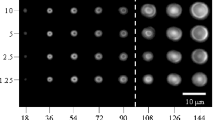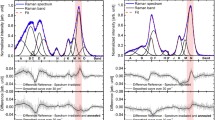Abstract
Application of femtosecond lasers is widely utilized in micromachining transparent materials. We have successfully altered the surface hardness of various commercial silicate glasses using a high-intensity femtosecond pulse laser. The femtosecond laser generates pulse energy of 500 nJ with a central wavelength of 800 nm. Using a peak power of 2.2 W and a repetition rate of 5.1 MHz, we observed an 18–20% increase surface hardness in glasses with low-modifier content and 16.6% decrease in glasses with high-modifier content. All laser exposed glasses show no detectable induced-crystallization or surface ablation. X-ray photoelectron spectroscopy results of our samples confirmed that the laser irradiation had no detectable effect on surface chemistry. X-ray reflectometry data showed the change in hardness was attributed to a thin layer with modified density. Experimental results suggest the strengthening mechanism derives from local structural transformation of interatomic bond distances and angles.






Similar content being viewed by others
References
D. Tan et al., Femtosecond laser induced phenomena in transparent solid materials: fundamentals and applications. Prog. Mater. Sci. 76, 154–228 (2016)
K.M. Davis et al., Writing waveguides in glass with a femtosecond laser. Opt. Lett. 21(21), 1729–1731 (1996)
R.R. Gattass, E. Mazur, Femtosecond laser micromachining in transparent materials. Nat. Photonics 2(4), 219–225 (2008)
S. Kanehira, K. Miura, K. Hirao, Ion exchange in glass using femtosecond laser irradiation. Appl. Phys. Lett. 93(2), 023112 (2008)
B. Poumellec et al., Modification thresholds in femtosecond laser processing of pure silica: review of dependencies on laser parameters [Invited]. Opt. Mater. Express 1(4), 766–782 (2011)
B. Poumellec et al., Femtosecond laser irradiation stress induced in pure silica. Opt. Express 11(9), 1070–1079 (2003)
C.B. Schaffer, Interaction of Femtosecond Laser Pulses with Transparent Materials (Diss. Harvard University, 2001)
A. Abou Khalil et al., Comparative study between the standard type I and the type A femtosecond laser induced refractive index change in silver containing glasses. Opt. Mater. Express 9(6), 2640–2651 (2019)
D.J. Little et al., Mechanism of femtosecond-laser induced refractive index change in phosphate glass under a low repetition-rate regime. J. Appl. Phys. 108(3), 033110 (2010)
C. D’Amico et al., Ultrafast laser-induced refractive index changes in Ge15As15S70 chalcogenide glass. Opt. Mater. Express 6(6), 1914–1928 (2016)
S. Gross, M. Dubov, M.J. Withford, On the use of the type I and II scheme for classifying ultrafast laser direct-write photonics. Opt. Express 23(6), 7767–7770 (2015)
V.R. Bhardwaj et al., Femtosecond laser-induced refractive index modification in multicomponent glasses. J. Appl. Phys. 97(8), 083102 (2005)
D. Ehrt et al., Femtosecond-laser-writing in various glasses. J. Non-Cryst. Solids 345–346, 332–337 (2004)
S.M. Eaton et al., Heat accumulation effects in femtosecond laser-written waveguides with variable repetition rate. Opt. Express 13(12), 4708–4716 (2005)
T. Gorelik et al., Transmission electron microscopy studies of femtosecond laser induced modifications in quartz. Appl. Phys. A 76(3), 309–311 (2003)
J.W. Chan et al., Structural changes in fused silica after exposure to focused femtosecond laser pulses. Opt. Lett. 26(21), 1726–1728 (2001)
V.R. Bhardwaj et al., Stress in femtosecond-laser-written waveguides in fused silica. Opt. Lett. 29(12), 1312–1314 (2004)
F. Luo et al., Redistribution of elements in glass induced by a high-repetition-rate femtosecond laser. Opt. Express 18(6), 6262–6269 (2010)
M. Shimizu et al., Formation mechanism of element distribution in glass under femtosecond laser irradiation. Opt. Lett. 36(11), 2161–2163 (2011)
T. Seuthe et al., in Compositional Dependent Response of Silica-Based Glasses to Femtosecond Laser Pulse Irradiation, vol 8885 (2013), p. 88850M
E. Mazur, Structural changes induced in transparent materials with ultrashort laser pulses. Ultrafast Lasers: Technol. Appl. 80, 395 (2002)
V.P. Veiko et al., Femtosecond laser-induced stress-free ultra-densification inside porous glass. Laser Phys. Lett. 13(5), 055901 (2016)
M. Douay et al., Densification involved in the UV-based photosensitivity of silica glasses and optical fibers: fiber gratings, photosensitivity, and poling. J. Lightwave Technol. 15(8), 1329–1342 (1997)
J. Liu, Simple technique for measurements of pulsed Gaussian-beam spot sizes. Opt. Lett. 7(5), 196–198 (1982)
R.G.C. Beerkens, Modeling the kinetics of volatilization from glass melts. J. Am. Ceram. Soc. 84(9), 1952–1960 (2001)
H. Van Limpt, R. Beerkens, O. Verheijen, Models and experiments for sodium evaporation from sodium-containing silicate melts. J. Am. Ceram. Soc. 89(11), 3446–3455 (2006)
N.P. Mellott, S. Brantley, C. Pantano, Topography of polished plates of albite crystal and glass during dissolution. Water Rock Interact. Ore Deposits Environ. Geochem. Tribute David A. Crerar 7, 83–95 (2001)
M.M. Smedskjaer, M. Jensen, Y. Yue, Effect of thermal history and chemical composition on hardness of silicate glasses. J. Non-Cryst. Solids 356(18), 893–897 (2010)
J. Petrovic, Durability of the refractive index change induced by a single femtosecond laser pulse in glass. Opt. Mater. X 1, 100004 (2019)
A. Fuerbach, S. Gross, D. Little, A. Arriola, M. Ams, P. Dekker, M. Withford, Refractive index change mechanisms in different glasses induced by femtosecond laser irradiation. in Pacific Rim Laser Damage 2016: Optical Materials for High Power Lasers, vol. 9983 (Yokohama, Japan, 2016). https://doi.org/10.1117/12.2237368
K. Mishchik, Ultrafast Laser-Induced Modification of Optical Glasses: A Spectroscopy Insight into the Microscopic Mechanisms (Université Jean Monnet, Saint-Etienne, 2012)
Author information
Authors and Affiliations
Corresponding author
Additional information
Publisher's Note
Springer Nature remains neutral with regard to jurisdictional claims in published maps and institutional affiliations.
Rights and permissions
About this article
Cite this article
Locker, S., Sundaram, S.K. Ultrafast modification of oxide glass surface hardness. Appl. Phys. B 125, 225 (2019). https://doi.org/10.1007/s00340-019-7334-5
Received:
Accepted:
Published:
DOI: https://doi.org/10.1007/s00340-019-7334-5




